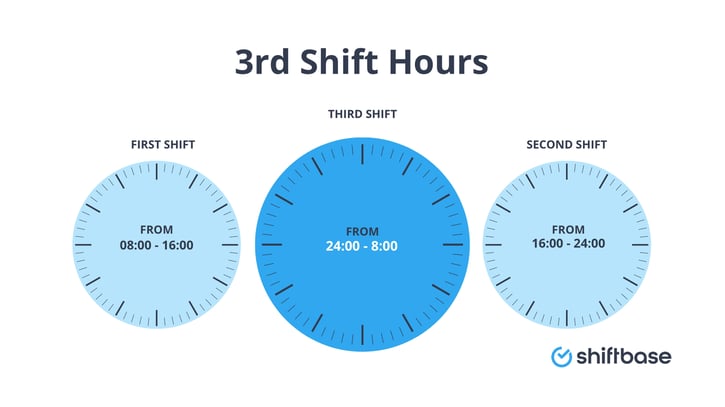This guide aims to provide a clear and comprehensive understanding of third-shift work, its structure, the industries it benefits, and the advantages it offers to businesses.
What is a third-shift schedule?
A third-shift schedule, often known as the graveyard shift or overnight shift, involves working hours that typically fall outside the conventional daytime and evening hours. It's the last shift of the day, usually covering the early morning hours (first shift) when most of the world is asleep.
The typical hours for third-shift workers usually span from midnight to the early morning, though this can vary based on the company's needs and industry standards. The structure of third-shift work can include:
- Fixed Work Hours: These are predetermined hours, for example, from midnight to 8 AM.
- Rotating Shifts: Employees may alternate between different shifts, including third shifts.
- Lesser Staff and Smaller Management Team: Often, fewer employees work during these hours, leading to a smaller on-site management team.
- Unique Challenges: Workers might face challenges like maintaining a healthy sleep schedule and balancing social life.
Key industries and roles that utilize third-shift
Various industries rely heavily on third-shift workers to maintain continuous operations. These include:
- Healthcare: Nurses, doctors, and other healthcare professionals often work overnight shifts to provide constant patient care.
- Manufacturing: Continuous production lines in factories often require third-shift workers.
- Security and Law Enforcement: To ensure public safety, officers and security personnel work through the night.
- IT and Tech Support: To offer round-the-clock customer support, many IT companies schedule employees for night shifts.
- Transportation and Logistics: Truck drivers and warehouse staff often work overnight to keep supply chains moving.
Benefits of implementing a third-shift schedule
Implementing a third-shift schedule can bring numerous advantages to businesses, each contributing to overall growth and efficiency. Here's a closer look at the key benefits:
Increased productivity and operational hours
-
Extended Operations: By adopting a third-shift schedule, businesses essentially operate round-the-clock. This uninterrupted workflow significantly increases overall output and productivity.
-
Optimized Equipment Use: Continuous operations mean that equipment and facilities are used more efficiently, reducing idle time and maximizing investment.
-
Focused Work Environment: Night shift workers often report fewer distractions, leading to a more focused work environment. With fewer meetings and less administrative tasks, employees can concentrate better on their tasks.
Meeting customer demand in a 24/7 economy
-
Global Market Accessibility: In our global economy, customers across different time zones can be serviced effectively. This is particularly crucial for industries like IT support, customer service, and e-commerce.
-
Enhanced Service Delivery: By extending hours, businesses can offer services during times when competitors might be closed, thereby improving customer satisfaction and loyalty.
-
Flexibility in Handling Workload: With a third-shift schedule, businesses can manage workload peaks more efficiently, as tasks can be spread out over 24 hours instead of being concentrated in the regular business hours.
Strategic advantages for business growth
-
Competitive Edge: Operating during late hours can give businesses a competitive advantage, as they can offer services when others are closed.
-
Attracting a Diverse Workforce: Offering night shifts can attract a wider range of employees, including those who prefer or need to work outside typical business hours due to personal commitments or lifestyle preferences.
-
Reduced Congestion and Operational Costs: Night shifts can mean less traffic and smoother logistics operations, leading to potentially lower transportation and operating costs.
-
Opportunity for Employee Growth: Night shifts often require employees to take on more responsibilities due to the smaller staff, which can accelerate skill development and career growth.
Challenges of third-shift work

While third-shift work offers several benefits, it also comes with its own set of challenges. Understanding and addressing these is crucial for the well-being of employees and the overall success of the shift system.
Health and safety concerns for employees
-
Disrupted Sleep Hours: Third shift employees often struggle with disrupted sleep patterns, as working overnight hours goes against the body's natural circadian rhythms. This can lead to sleep disorders and fatigue.
-
Increased Health Risks: Prolonged exposure to third shift hours can increase the risk of certain health issues like cardiovascular diseases, gastrointestinal problems, and mental health issues.
-
Workplace Safety: Fatigue from irregular sleep hours can also lead to reduced focus and alertness, potentially increasing the risk of accidents and errors, especially in jobs requiring high levels of concentration or physical activity.
Work-life balance issues
-
Social Isolation: Employees working the third shift might find it challenging to maintain social connections, as their work schedule is the reverse of most people, including family and friends.
-
Juggling Family and Personal Responsibilities: Balancing family life, especially for parents working third-shift hours, can be difficult. This includes managing childcare and attending important events or appointments that occur during regular daytime hours.
-
Limited Access to Services: Many services, from banks to healthcare, operate during standard business hours, making it challenging for third-shift workers to access them.
Managing employee morale and retention
-
Feeling of Isolation at Work: The smaller staff numbers during third shifts can lead to a sense of isolation among employees. This can affect their morale and sense of belonging within the workplace.
-
Retention Challenges: The unique challenges of third-shift work can make it difficult to attract and retain employees. This is particularly true for new employees who might not have anticipated the extent of the adjustment required.
-
Inconsistent Workplace Meetings and Training: Scheduling meetings and training sessions that include third-shift employees can be challenging, leading to potential communication gaps and a feeling of being left out of important discussions and decisions.
These challenges emphasize the need for employers to develop strategies that support third-shift employees.
Best practices for third-shift management
Managing a third-shift workforce effectively requires a different approach than traditional day shifts. Implementing best practices can ensure a productive, safe, and satisfied workforce.
Creating a safe and healthy work environment
Ensuring a safe and healthy work environment is crucial for third-shift employees, as they face unique health risks and safety challenges due to the unconventional hours.
-
Regular Health Screenings: Provide routine health checks to monitor and address any health concerns related to third-shift work.
-
Optimize Lighting and Ergonomics: Improve workplace lighting to enhance visibility and reduce eye strain. Ergonomically designed workstations can help reduce physical strain.
-
Encourage Healthy Habits: Promote a culture of wellness by providing information on maintaining a healthy sleep schedule, nutrition advice for night workers, and access to fitness facilities if possible.
Implementing fair compensation and benefits
Competitive compensation and benefits are key to attracting and retaining third-shift workers, acknowledging the additional challenges they face.
-
Shift Differential Pay: Offer higher pay rates for third-shift hours to compensate for the inconvenience and challenges of night work.
-
Enhanced Benefits Package: Provide benefits tailored to night shift workers, like additional health insurance options or flexible scheduling.
-
Time-off and Rest Break Policies: Ensure adequate rest breaks during shifts and offer more flexible time-off policies to help employees manage fatigue and work-life balance.
Strategies for effective communication and team building
Effective communication and team building are essential for maintaining morale and a sense of inclusion among third-shift workers.
-
Regular Meetings at Convenient Times: Schedule meetings at times that are convenient for third-shift employees, ensuring they are kept in the loop.
-
Use of Technology for Communication: Leverage technology like intranets, emails, and messaging apps to ensure continuous and effective communication across different shifts.
-
Team Building Activities: Organize team-building activities that third-shift workers can participate in, to foster a sense of community and belonging.
Providing training and support for third-shift workers
Training and support are vital for the professional development and job satisfaction of third-shift employees, ensuring they feel valued and competent in their roles.
-
Tailored Training Programs: Develop training programs that cater to the unique needs and schedules of third-shift workers.
-
Mentorship and Support Systems: Implement mentorship programs where experienced night shift workers can guide new employees through the challenges of adjusting to the night shift.
-
Focus on Mental Health Support: Provide access to counseling services and support groups specifically geared towards addressing the mental health challenges associated with third-shift work.
Implementing these best practices can greatly improve the experience and productivity of third-shift workers, ultimately benefiting the overall performance and morale of the business.
Tools and resources for third-shift management

Effective management of third-shift employees often hinges on the use of appropriate tools and resources, particularly in terms of scheduling and monitoring. These tools can streamline operations, ensure fairness, and maintain a high level of productivity and employee satisfaction.
Workforce management software (e.g., Kronos, Workday):
These platforms offer comprehensive scheduling solutions, allowing for the creation and management of complex shift schedules. They can handle shift rotations, time-off requests, and ensure compliance with labor laws.
Time and attendance systems (e.g., TSheets, When I Work):
These tools track employee work hours accurately, including clock-in and clock-out times. They are essential for calculating overtime and ensuring fair pay for third-shift workers.
Employee communication Apps (e.g., Slack, Microsoft Teams):
These applications facilitate real-time communication between team members, crucial for third-shift workers who may be working during off-hours for the rest of the management team.
Task management tools (e.g., Asana, Trello):
These tools help in assigning and tracking tasks and projects. They're particularly useful for third-shift teams to stay aligned with the company's goals and priorities.
Health and wellness Apps (e.g., Headspace, MyFitnessPal):
Focused on promoting healthy habits, these apps can support third-shift workers in managing stress, nutrition, and exercise, which is vital given their unconventional work hours.
Online training platforms (e.g., Udemy, Coursera):
These platforms offer a wide range of courses that third-shift employees can access at their convenience, helping them to develop new skills or enhance existing ones.
These software solutions streamline payroll processing, including handling shift differentials and other complexities associated with third-shift work schedules.
Safety monitoring systems (e.g., SafetyCulture, EHS Insight):
These tools help in monitoring and ensuring workplace safety, which is particularly important for third-shift workers who might face different risks compared to daytime employees.
Each of these tools can play a crucial role in effectively managing third-shift workers, ensuring their needs are met while maintaining operational efficiency and compliance.

Employee scheduling and Time-tracking software!
Conclusion
Managing third-shift workers effectively is crucial for the success of businesses operating around the clock.
Addressing their unique challenges with appropriate practices and tools, such as advanced scheduling software and wellness resources, is essential.
This approach ensures productivity, employee satisfaction, and contributes significantly to the overall efficiency and adaptability of the business in a 24/7 economy.
Elevate your third shift scheduling with Shiftbase
Managing a third shift schedule can be a daunting task, but with Shiftbase, it becomes a streamlined and efficient process. Utilizing the powerful employee scheduling feature of Shiftbase, businesses can effortlessly organize and manage overnight work hours, ensuring seamless operations during the challenging graveyard shift.
The time tracking capabilities of Shiftbase are particularly beneficial for accurately monitoring and managing the unique demands of night shifts. Moreover, its absence management system ensures that any unexpected staff shortages during these critical hours are quickly addressed, maintaining operational continuity and workforce efficiency.
To transform your approach to third shift scheduling, try Shiftbase free for 14 days by signing up here. Experience firsthand how Shiftbase can optimize your night shift operations and enhance overall workforce management.



